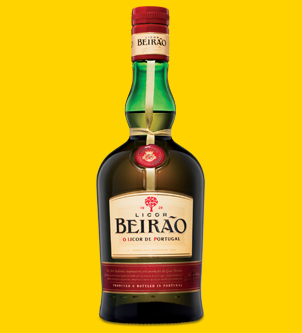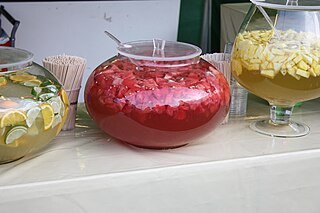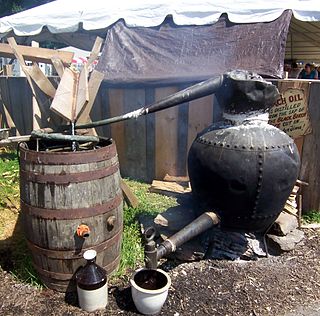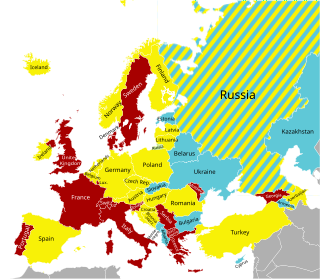
A wine cooler is an alcoholic beverage made from wine and fruit juice, often in combination with a carbonated beverage and sugar.

A wine cooler is an alcoholic beverage made from wine and fruit juice, often in combination with a carbonated beverage and sugar.
In Germany, wine coolers became popular in 2004, when the German government imposed an extra duty on alcopops (pre-mixed spirits) of 0.80 to 0.90 euro per bottle, effective 1 August 2004. To circumvent higher taxation, some German producers have switched to wine coolers, which are being marketed in the same way as alcopops.[ citation needed ]
Wine (15-17% ABV) contains 2.4-2.7 times more water than 40% distilled spirit. Since wine contains approximately 85% water, it can be mixed with concentrates like a drink mixer, fruit syrup, or squash concentrate. Typically includes 3–7% fruit juice is added to the wine to dilute the ABV, and this solution can be carbonated with a soda machine to make alcopop, after which soft drink syrup is added, which lowers the ABV further.
Traditionally home-made, wine coolers have been bottled and sold by commercial distributors since the early 1980s, [1] especially in areas where their alcohol content, lower than wine, causes them to come under less restrictive laws than table wines. [2]
Because most of the flavor in the wine is obscured by the fruit and sugar, the wine used in wine coolers tends to be of the cheapest available grade. Since January 1991, when the United States Congress quintupled the excise tax on wine, [3] most producers of wine coolers dropped wine from the mix, substituting it with cheaper malt liquor. [4] These malt-based coolers, while sometimes referred to as "wine coolers", are in a different category of beverage—sometimes called "malt beverage", "malternative", or just "cooler". Bartles & Jaymes refers to its malt beverage as a "flavored malt cooler". [5]

An alcopop is any of certain mixed alcoholic beverages with relatively low alcohol content, including:

A drink or beverage is a liquid intended for human consumption. In addition to their basic function of satisfying thirst, drinks play important roles in human culture. Common types of drinks include plain drinking water, milk, juice, smoothies and soft drinks. Traditionally warm beverages include coffee, tea, and hot chocolate. Caffeinated drinks that contain the stimulant caffeine have a long history.

A liqueur is an alcoholic drink composed of spirits and additional flavorings such as sugar, fruits, herbs, and spices. Often served with or after dessert, they are typically heavily sweetened and un-aged beyond a resting period during production, when necessary, for their flavors to mingle.

Vodka is a clear distilled alcoholic beverage. Different varieties originated in Poland, Russia, and Sweden. Vodka is composed mainly of water and ethanol but sometimes with traces of impurities and flavourings. Traditionally, it is made by distilling liquid from fermented cereal grains and potatoes since the latter was introduced in Europe in the 18th century. Some modern brands use corn, sugar cane, fruits, honey, and maple sap as the base.
Schnapps or schnaps is a type of alcoholic beverage that may take several forms, including distilled fruit brandies, herbal liqueurs, infusions, and "flavored liqueurs" made by adding fruit syrups, spices, or artificial flavorings to neutral grain spirits.

Smirnoff is a brand of vodka owned and produced by the British company Diageo. The Smirnoff brand began with a vodka distillery founded in Moscow by Pyotr Arsenievich Smirnov (1831–1898). It is distributed in 130 countries, and manufactured locally in some, as in Illinois in the United States.

The term punch refers to a wide assortment of drinks, both non-alcoholic and alcoholic, generally containing fruits or fruit juice. The drink was introduced from the Indian subcontinent to England by employees of the East India Company in the late 17th century. Punch is usually served at parties in large, wide bowls, known as punch bowls.

Aguardente (Portuguese), or aguardiente (Spanish), is a type of distilled alcoholic spirit that contains between 29% and 60% alcohol by volume (ABV). It is a somewhat generic term that can refer to liquors made from various foods. It originates from and is typically consumed on the Iberian Peninsula and in Iberian America.

Liquor is an alcoholic drink produced by the distillation of grains, fruits, vegetables, or sugar that have already gone through alcoholic fermentation. Other terms for liquor include: spirit, distilled beverage, booze, spirituous liquor or hard liquor. The distillation process concentrates the liquid to increase its alcohol by volume. As liquors contain significantly more alcohol (ethanol) than other alcoholic drinks, they are considered "harder." In North America, the term hard liquor is sometimes used to distinguish distilled alcoholic drinks from non-distilled ones, whereas the term spirits is more commonly used in the UK. Some examples of liquors include vodka, rum, gin, and tequila. Liquors are often aged in barrels, such as for the production of brandy and whiskey, or are infused with flavorings to form flavored liquors, such as absinthe.

Kilju is the Finnish word for home made alcoholic beverage typically made of sugar, yeast, and water.

Birch beer is a beverage, commonly found as a carbonated soft drink made from herbal extracts and birch bark. There are dozens of brands of birch beer available.

Flavored fortified wines or tonic wines are inexpensive fortified wines that typically have an alcohol content between 13% and 20% alcohol by volume (ABV). They are made from various fruits with added sugar, artificial flavor, and artificial color.
An alcohol-free or non-alcoholic drink, also known as a temperance drink, is a version of an alcoholic drink made without alcohol, or with the alcohol removed or reduced to almost zero. These may take the form of a non-alcoholic mixed drink or non-alcoholic beer, and are widely available where alcoholic drinks are sold.

Korn, also known as Kornbrand or Kornbranntwein, is a German colorless distilled beverage produced from fermented cereal grain seed. The production of Korn uses only five grains: most of the production is based on rye or wheat; barley is mainly used to obtain the required malt for the brewing process; oats and buckwheat are rarely used. The addition of food colorings, flavorings, or sweeteners is not permitted. Korn is distilled to lower alcoholic proofs and less rigorously filtered than vodka, which leaves more of the cereal grain flavor in the finished spirit.
Ready to drink packaged beverages are those sold in a prepared form, ready for consumption. Examples include iced tea and alcopops.

An alcoholic beverage is a drink that contains ethanol, a type of alcohol and is produced by fermentation of grains, fruits, or other sources of sugar. The consumption of alcoholic drinks, often referred to as "drinking", plays an important social role in many cultures. Alcoholic drinks are typically divided into three classes—beers, wines, and spirits—and typically their alcohol content is between 3% and 50%.

There are ten states in the United States of America with container deposit legislation, popularly called "bottle bills" after the Oregon Bottle Bill, the first such legislation that was passed.
A malt drink is a fermented drink in which the primary ingredient is the grain, or seed, of the barley plant, which has been allowed to sprout slightly in a traditional way called "malting" before it is processed.